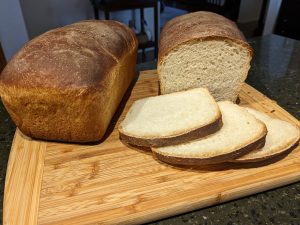101 - "World Bread"
A Bread From The rec.food.sourdough Recipes Project
This is, appropriately, the first recipe in the rec.food.sourdough recipe list. It is a simple recipe and because it uses an 
On the plus side, it has a lovely flavor and is a very good toasting bread due to the residual sugars from the milk. Milk? Yes, I use whole cows milk. You may substitute non-dairy milk, but if you want to use cow's milk, I suggest using whole milk.
This recipe started as a recipe in Dr. Ed Wood's book. "World Sourdoughs from Antiquity" which I consider to be a great place for sourdough bakers to start their journey. The rfs people modified the recipe, and I have modified it further to use our techniques.
Click on the link to see the original version in the rfs recipes file.
Let's start with the ingredients:
| Volumetric Measure (Cups) | Ingredient | Grams | Baker's Percentage |
|---|---|---|---|
| 3/4 Cup | Whole Milk | 190 Grams | 33.6% |
| 4 3/4 tsp | Unsalted Butter | 22.3 Grams | 3.99% |
| 3 1/2 Cups | Active Sourdough Starter | 760 Grams | 136.36% |
| 4 1/3 Cups | Unbleached and Unbromated All-Purpose Flour | 560 Grams | 100% |
| 5 3/4 tsp | Sugar | 28.7 Grams | 5.14% |
| 1 1/2 tsp | Salt | 9.6 Grams | 1.72% |
We used King Arthur's Sir Galahad flour, which King Arthur says is comparable to a French type 55 flour or an American All-Purpose flour.
You can make this using hand kneading or machine kneading to develop the dough - it is a bit dense for stretch and fold. If you develop the dough in a mixer, I suggest adding all the ingredients to the mixing bowl, mix on low speed for 5 minutes, let the dough rest for 5 more minutes, and knead on low speed until the dough is well developed, usually about 5 minutes. This dough starts out looking WAY to dry with too much flour. However, as you knead the flour will be incorporated into the loaf, and then the loaf will feel tacky. Not really sticky, but tacky, and that's OK.
Once the dough is developed, put it into a bowl and let it rise by about 40%. This took about 3 hours in our Brød And Taylor Folding Proofer at 75F/24C. Once the dough is done with its first rise, or bulk ferment, divide it into two loaves. I made pan loaves, you can make any style loaf you prefer. It took about 2 hours for the dough to rise. Remember to look at the loaves, and not the clock.
Once the dough had risen it was time to bake. In a regular oven, I suggest baking at 375F/190C for about 45 minutes. Steam in the oven for the first ha;f of the bake is suggested for good oven spring and crust development. Rotate the loaves half way through the bake.
Recently I acquired an Anova Precision Oven. If the size of the oven works for you, I can recommend it highly. You can control the amount of steam in the oven and program the baking stages. I told the oven to preheat to 350F/175C, then to bake for 15 minutes at 350F/175C with 100% humidity. After 15 minutes, I told the oven to turn off the steam and raise the temperature to 375F/190C for another 20 minutes. The results were very gratifying! I'll post a review of the Anova Precision Oven soon.

